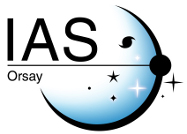Observation of H2O in a strongly lensed Herschel-ATLAS source at z=2.3
| Titre | Observation of H2O in a strongly lensed Herschel-ATLAS source at z=2.3 |
| Type de publication | Journal Article |
| Year of Publication | 2011 |
| Auteurs | Omont, A, Neri, R, Cox, P, Lupu, R, Guelin, M, van der Werf, P, Weiss, A, Ivison, R, Negrello, M, Leeuw, L, Lehnert, M, Smail, I, Verma, A, Baker, AJ, Beelen, A, Aguirre, JE, Baes, M, Bertoldi, F, Clements, DL, Cooray, A, Coppin, K, Dannerbauer, H, de Zotti, G, Dye, S, Fiolet, N, Frayer, D, Gavazzi, R, Hughes, D, Jarvis, M, Krips, M, Michalowski, MJ, Murphy, EJ, Riechers, D, Serjeant, S, Swinbank, AM, Temi, P, Vaccari, M, Vieira, JD, Auld, R, Buttiglione, B, Cava, A, Dariush, A, Dunne, L, Eales, SA, Fritz, J, Gomez, H, Ibar, E, Maddox, S, Pascale, E, Pohlen, M, Rigby, E, Smith, DJB, Bock, J, Bradford, CM, Glenn, J, Scott, KS, Zmuidzinas, J |
| Journal | Astronomy & Astrophysics |
| Volume | 530 |
| Date Published | Jun |
| ISBN Number | 0004-6361 |
| Numéro d'accès | WOS:000291027400156 |
| Résumé | The Herschel survey, H-ATLAS, with its large areal coverage, has recently discovered a number of bright, strongly lensed high-z submillimeter galaxies. The strong magnification makes it possible to study molecular species other than CO, which are otherwise difficult to observe in high-z galaxies. Among the lensed galaxies already identified by H-ATLAS, the source J090302.9-014127B (SDP.17b) at z = 2.305 is remarkable because of its excitation conditions and a tentative detection of the H2O 2(02)-1(11) emission line (Lupu et al. 2010, ApJ, submitted). We report observations of this line in SDP.17b using the IRAM interferometer equipped with its new 277-371 GHz receivers. The H2O line is detected at a redshift of z = 2.3049 +/- 0.0006, with a flux of 7.8 +/- 0.5 Jy km s(-1) and a FWHM of 250 +/- 60 km s(-1). The new flux is 2.4 times weaker than the previous tentative detection, although both remain marginally consistent within 1.6 sigma. The intrinsic line luminosity and ratio of H2O(2(02)-1(11))/CO(8-7) are comparable with those of the nearby starburst/enshrouded-AGN Mrk 231, and the ratio I(H2O)/L-FIR is even higher, suggesting that SDP.17b could also host a luminous AGN. The detection of a strong H2O 2(02)-1(11) line in SDP.17b implies an efficient excitation mechanism of the water levels that must occur in very dense and warm interstellar gas probably similar to Mrk 231. |



